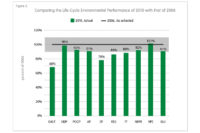Improving the sustainability of flexible packaging was a recurring theme at this year’s Global Pouch Forum, held June 13-15 in Rosemont, IL. While pouches are recognized by many as one of the most sustainable forms of packaging due primarily to their minimal use of material and excellent product/package ratios, flexible packaging may still face unfavorable public perceptions.
While consumers like flexible packaging for its shelf appeal, product protection and convenience, many express concern that it is not recyclable and usually ends up in landfills or is washed into our waterways. The laminated structures that do so much to prevent food waste and extend the shelf life of products also can make recycling impractical.
Even though flexible packaging is the fastest-growing segment of the industry, it is the public perception that sustainability means recyclability which stands in the way of even faster growth. This has become especially apparent in the last year, with growing resistance to the plastics used in most flexible packaging. These environmental concerns are impacting consumer purchasing decisions.
Flexible Packaging Offers Triple Win
Sal Pellingra, ProAmpac’s vice president for application & innovation development and a presenter at the Global Pouch Forum, pointed out that companies can improve their packaging sustainability by adopting flexible packaging.
“One approach that makes a significant impact to the environment is to reduce the amount of packaging being used. That is what flexible packaging can do,” Pellingra stated in remarks at the Forum. “That means right now, you have an immediate opportunity for a triple sustainability win.” His triple sustainability-win formula is as follows:
First, you win by shifting to flexible packaging. Reducing the amount of packaging means less carbon impact, less water usage, less fossil fuel, lower product-to-package ratio, less material-to-landfill, and less weight and fuel for transport.
Second, you win again by introducing available sustainability-facing solutions. Employing renewable, recyclable and post-consumer recycled (PCR)-based materials that are available today.
Third, you win by driving consumer acceptance through new package functionality. Utilizing flexible packaging with compelling and useful functional features such as dispensing, reclose-ability, dosing, one-way valves and other features that add utility and value.
However, the industry recognizes the recycling impediment, and suppliers are working globally to find ways to make pouches more sustainable. In this article, we examine recent innovations and product launches that should form a solid basis for growth in this sector.
Making Multilayer Packaging Recyclable
Multilayer packaging reliably ensures high-quality and fresh food products thanks to its properties. It protects the products and keeps them hygienic, thereby extending the shelf life of food. Smart solutions with multilayer packaging can play a part in reducing this unnecessary waste.
Multilayer packaging can be sustainable and may be produced from chemically recycled material.
“Today’s high-tech film packaging solutions consist of multiple materials and layers with different properties, such as an oxygen barrier. And thanks to the optimized use of materials, we were able to reduce the packaging volume to a minimum,” said Johannes Remmele, managing director of Südpack, one of four European companies involved in a project to perform chemical recycling.
Multilayer packaging consists of up to 11 individual, ultra-thin layers, making it considerably lighter and thinner than comparable packaging. In addition to reducing the amount of raw materials used, this also contributes to considerably lowering CO2 emissions during transport. All in all, multilayer packaging is clearly more resource efficient than its alternatives.
However, multilayer packaging could only be recycled to a limited extent, because mechanical recycling processes are not suitable for composite materials. “Within the ChemCycling project, BASF is working on advancing the chemical recycling of plastic waste, because this will make it possible to process and reuse previously non-recyclable plastics such as mixed plastics. In collaboration with our partners, we have now for the first time produced a prototype packaging made of chemically recycled polyamide and polyethylene. This goes to show that the recycling of multilayer packaging could soon come full circle,” explained Christoph Gahn, who is responsible for the polyamide business at BASF.
This pilot project was made possible through the collaboration between the four partners BASF, Borealis, Südpack and Zott. BASF supplies chemically recycled polyamide, while Borealis provides sustainably produced polyethylene. Südpack, one of Europe’s leading producers of film packaging for food products, uses these materials to produce multilayer film for a specially sealed Mozzarella packaging for Zott Gourmet Dairy.
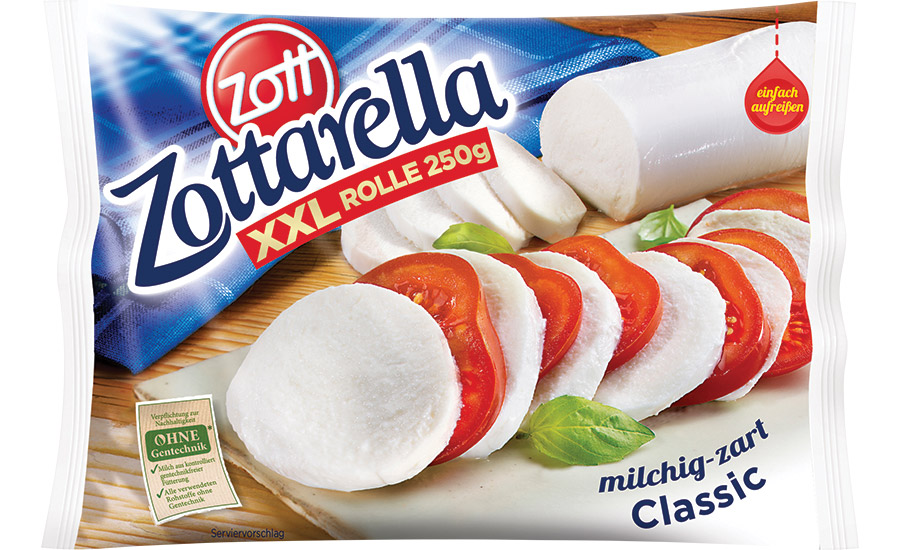
“What is special about this pilot project is that both components of the packaging — polyamide and polyethylene — are made from chemically recycled material,” emphasized Maurits van Tol, Borealis senior vice president innovation, technology & circular economy solutions. “This innovative solution came about thanks to the selection of special polymers. In addition, the collaboration between the companies involved made it possible for the first time to consistently certify each step up from the raw material to the finished packaging.”
The raw materials for polyamide and polyethylene were produced in very small quantities as part of the “ChemCycling” project. The pyrolysis oil derived from plastic waste was supplied by a partner and fed into BASFs production as feedstock. According to the certified mass balance method, both plastics have an allocated 100 percent share of recycled materials.
Cheer Pack Gives Shape To Pouches
Compared to glass or plastic containers, CHEERPlus Cubes allow brand owners to merchandise product in a more compact, sustainable and convenient package.
“We’re very excited to be the first company in North American to offer three standard sizes of side gusset spouted pouches available to brand owners who want to differentiate their brand,” says Al Madonna, Cheer Pack North America marketing director.
CPNA is the first company in North America to market side gusset spouted pouches in three standard sizes – 250 ml, 330 ml, and 500 ml – and the company plans to roll out larger size options in 2020. In addition to the brick-and-mortar retail marketplace, flexible spouted pouches from CPNA have emerged as an ideal e-commerce grocery packaging solution for a wide range of product categories that include baby food, energy and nutrition products, sauces and condiments, and hand lotions.
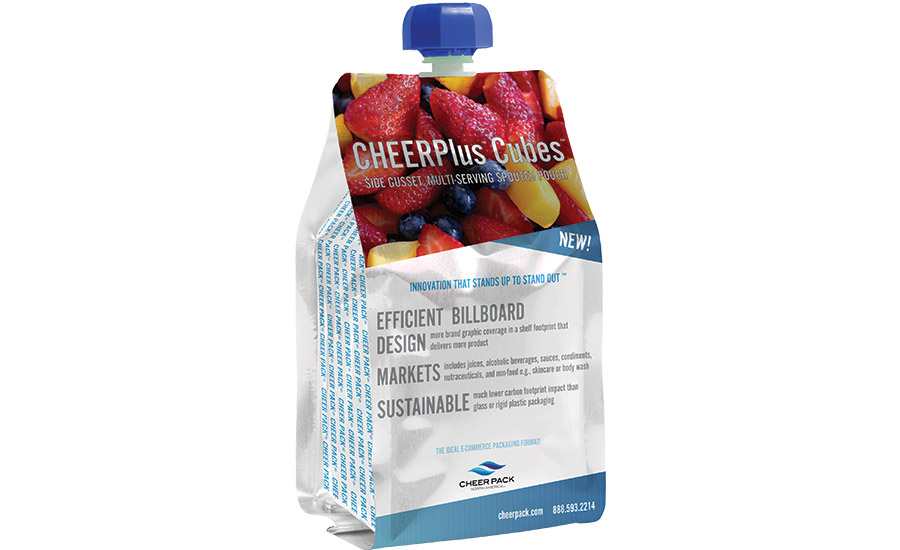
By making eco-friendly sustainable flexible packaging that includes its CHEERPlus Cubes line of products, CPNA is committed to decreasing its carbon footprint through environmentally-conscious practices. CPNA’s stand-up pouches for food and non-food packaging create between 75 and 93 percent less greenhouse gas emissions compared to other packaging types. Additionally, with a 35-to-1 product-to-package ratio, stand-up pouches provide the most efficient package delivery system available, relative to other popular package types.
Pouch Improves Sustainability
Uncle Dougie’s — maker of natural and organic sauces, marinades and rubs — is dramatically reducing its carbon footprint by shifting to a flexible pouch for its newest line of barbeque sauces. As the first condiment company to debut the inverted flexible squeeze pouch, the brand is setting the bar for sustainability in a category dominated by rigid glass and plastic bottles.
In partnership with Glenroy, the company responsible for producing the new squeeze pouches, Uncle Dougie’s worked with the Natural Marketing Institute to measure the environmental footprint and sustainability of squeeze pouches against typical glass barbeque sauce bottles. Results of this study show that the squeeze pouches:
- Reduce fossil fuel usage by 65 percent
- Reduce greenhouse emissions by 78 percent
- Reduce overall water usage by 80 percent
“We wanted to understand our environmental impact from a holistic standpoint and look for ways to reduce our natural resource consumption as we launched these organic items,” said Rob Johnson, CEO of Uncle Dougie’s. “It’s important to make an impact where we can, and our fans expect us to do so. This package is a huge upgrade for convenience and usability, and proves you can bring meaningful innovation to consumers and do good for the planet at the same time.”
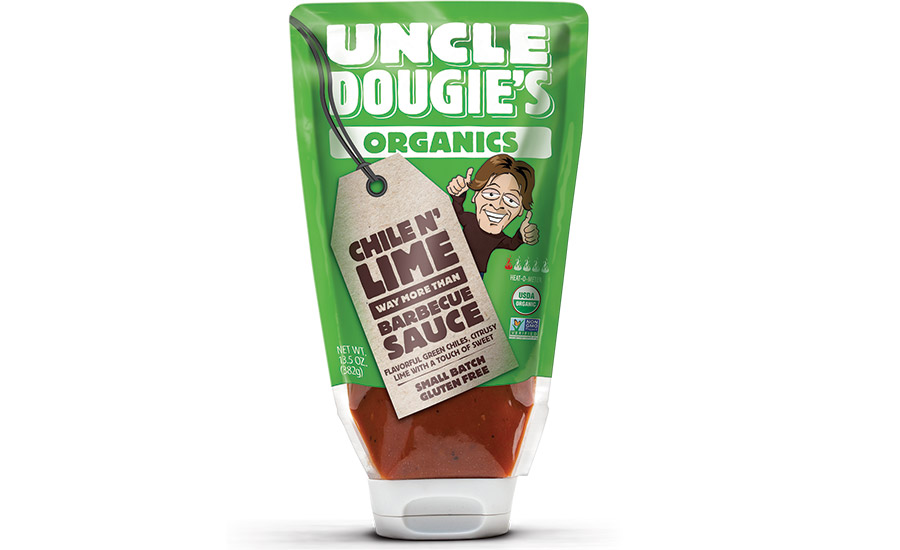
“We commend Uncle Dougie’s for spearheading this study and being a thought leader and change-maker in the category,” said Amanda Dahlby, marketing manager at Glenroy. “The Environmental Protection Agency considers source reduction to be the single most effective method of waste management because it’s a true preventive measure and addresses pollution at its source.”
While the inverted squeeze pouches are not yet recyclable, the packaging is more sustainable than glass due to its lower carbon footprint and natural resource utilization. Recyclable, flexible food grade plastic has yet to be developed, but Uncle Dougie’s will be in a unique position to immediately adopt this type of plastic once it becomes available.
Snack Bar Features Paper Packaging
A technical breakthrough in confectionery packaging will see Nestlé’s ‘YES!’ snack bars wrapped in recyclable paper for the first time. Nestlé is claiming a world first in recyclable packaging on confectionery after UK-based experts, working at its R&D center in York, discovered a way to use a recyclable paper wrapper in a high-speed ‘flow wrap cold seal’ packaging line.
The company’s new range of fruit-based and nut-based ‘YES!’ bars are the first brand to convert to the new technique beginning in July. Nestlé said it represents a world first for a process that, in the past, was only suitable for plastic films and laminates.
“Now we’ve turned our attention to the wrapper so that the packaging is sustainable and easy to recycle. It’s an important step as we work to make all of our packaging recyclable or reusable by 2025,” says Stefano Agostini, CEO for Nestlé in the UK and Ireland.
YES! bar wrappers will now carry the message ‘carefully wrapped in paper’ to reflect the work that has been done in adapting production lines to handle the new packaging more gently during the manufacturing process.
The new packaging is made of a coated paper that is widely recyclable with other paper. The paper itself comes from certified sustainable sources. Nestlé said the challenge was to find a way to use paper on high speed production lines that have been designed for more durable plastic or laminate packaging. The new wrapper then had to be tested extensively to make sure it would keep YES! bars in perfect condition during production, transport and storage.
Recycled Materials Used in Food Pouch
Taking a “pioneering step” toward sustainable food packaging, ProAmpac is producing a high-barrier pouch made with 25 percent post-consumer recycled (PCR) materials for Justin’s newest product innovation, Nut Butter Covered Nuts.
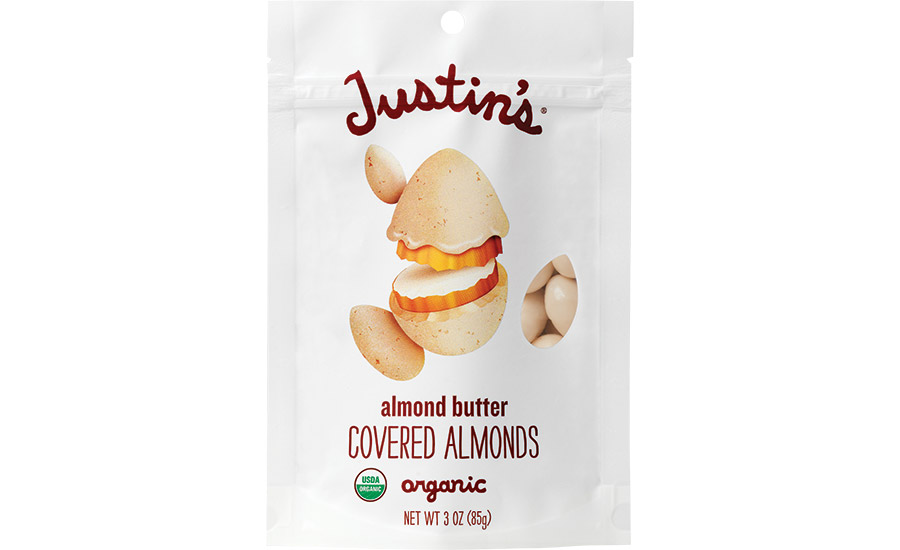
“This flexible package is one of the first commercial pouches for food packaging to combine such a high proportion of PCR material, reducing the carbon footprint of the package without sacrificing the high-barrier snack food requirements. We believe this is a pioneering step in food packaging to further enhance the sustainable advantages of a flexible format,” says Adam Grose, chief commercial officer for ProAmpac.
Utilizing a food-contact FDA-compliant structure, this snack pouch reduces its reliance on virgin resin by using 40 percent recycled plastic content in the sealant film that equates to
25 percent of the total structure. This pouch has high oxygen- and moisture-barrier properties, preserving product freshness, features crisp branded graphics and reduces the package’s total carbon footprint by not relying on 100 percent virgin polymers.
“We overcame the hazy and inconsistent appearance that typically occurs when utilizing a high content of PCR materials by combining flexographic inks and coating technologies, and by optimizing the lamination processes, all of which produces a package with standout shelf appeal,” explains Hesam Tabatabaei, ProAmpac’s director of research, innovation and technology.
Pet Food Employs Bio-Based Packaging
Braskem has partnered with Earth Animal, a manufacturer of veterinary formulated products, to announce a new sustainable packaging initiative using Braskem’s sugarcane based I’m green™ Polyethylene (PE) biopolymer.
“Earth Animal has always been passionate about how, why, and what we do, and for us, we have felt that sustainability is a major part of our DNA,” said Stephanie Volo, VP of marketing and sustainability for Earth Animal.
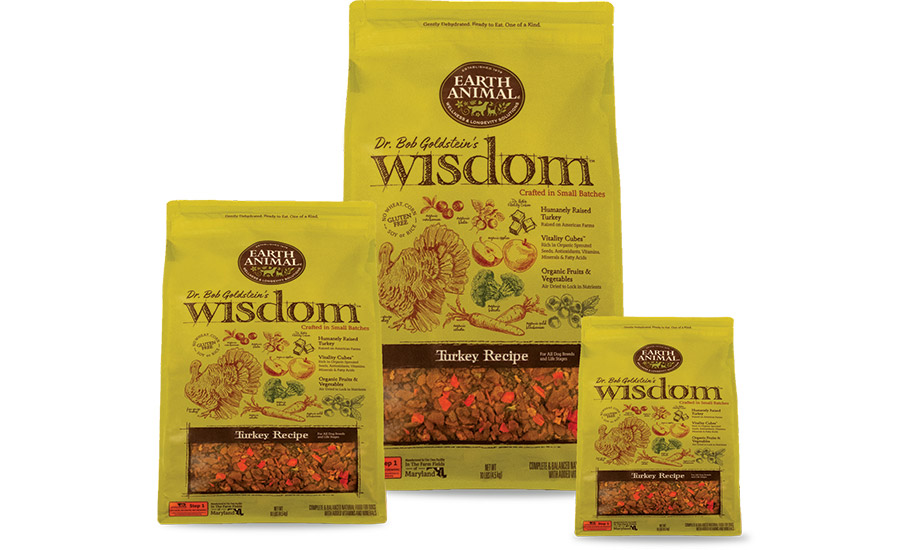
“For over 40 years, our promise has been to preserve and enhance the quality of life for animals, people and the earth. And, partnering with Peel Plastics and Braskem to design and develop our Wisdom Dog Food packaging using the PE biopolymer was a natural fit given each company’s commitment to sustainability.”
Earth Animal will include at least
30 percent bioplastic packaging material into every bag of new line of Dr. Bob Goldstein’s Wisdom Dog Food. To further enhance the environmental profile of the new more sustainable packaging, Earth Animal is partnering with TerraCycle in order to provide an end-of-life package recycling program.
Braskem’s bio-based resin is made from ethanol, a renewable and sustainable resource produced from Brazilian sugarcane. It retains the same properties, performance and application versatility of fossil fuel derived polyethylene, making it a drop-in substitute for conventional oil-based polyethylene.




